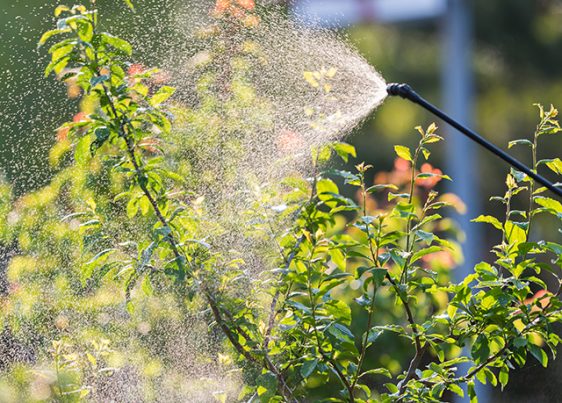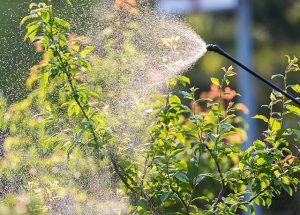
Permethrin – toxicity, side effects, diseases and environmental impacts
Thursday, January 04, 2018 by Janine Acero
http://www.naturalpedia.com/permethrin-toxicity-side-effects-diseases-and-environmental-impacts.html

Permethrin is a pyrethroid pesticide used as an acaricide and insect repellent. Pyrethroids are synthetic chemicals that act like natural extracts from the chrysanthemum flower (Chrysanthemum cinerariaefolium). Permethrin, in its pure chemical form, is characterized as either an odorless and colorless crystal solid or as a pale brown liquid.
As with all other synthetic pyrethroids, permethrin is a neurotoxin. It attacks an insect’s nervous system, causing muscle spasms, paralysis, and death. Products containing permethrin may be used in public health mosquito control programs. In recent years, it has also become a means to control ticks. Other insects that are affected by permethrin are cockroaches, termites, aphids, fleas, and ants.
Permethrin applications most often take the form of dust, wettable powders, spray solutions and emulsifiable concentrates.

List of known side effects
Dermal contact with permethrin may cause sensitivity to sound or touch, abnormal facial sensation, a sensation of tingling, prickling, numbness, burning, and itching. If permethrin gets in the eyes, it can cause redness, pain or burning. Ingesting permethrin can cause sore throat, abdominal pain, nausea, and vomiting. People that have breathed in permethrin have had irritation in the nose and lungs, difficulty breathing, headaches, dizziness, nausea and vomiting, excessive salivation and fatigue.
In severe cases, fluid in the lungs and muscle twitching may develop. Seizures may occur and are more common with more toxic cyano-pyrethroids.
Body systems affected by permethrin
Permethrin is suspected of causing enlargement of the liver and destruction of the lining of nerve tracts.
For its effects on humans, permethrin has been classified as a type II or III toxin by the Environmental Protection Agency (EPA), and studies of mice cells have demonstrated the chemical’s potential to be carcinogenic.
Items that can contain permethrin
Permethrin is most commonly used on wheat, corn, and alfalfa. Trace amounts of permethrin have been found in foods including bananas, collard greens, squash, and watermelon. It is also applied to a range of settings, on anything from home garden to agricultural fields to household pest control.
Several common trade names of permethrin include Ambush, BW-21-Z, Cellutec, Ectiban, Eksmin, Exmin, FMC-33297, Indothrin, Kafil, Kestril, NRDC 143, Pounce, PP 557, Pramiex, Qamlin, and Torpedo.
Products that contain permethrin as the active ingredient are the following:
- Fortefog P Fumer
- Ambush
- Exmin
- Kestril
- Ectiban
- Pynosect
- Corsair
Some manufacturers that supply such products include:
- Agropharm
- ICI Plant Protection
- Mitchell Cotts
- FMC
How to avoid permethrin
Occupational exposure to permethrin compounds may occur through inhalation of dust, and by dermal contact at workplaces where permethrin compounds are produced or used. The following are some protective measures to avoid any contact with permethrin:
- Use this material only in well-ventilated areas. In case of accidental aspiration, leave the area of contamination and go to an open space with fresh air. Seek medical attention immediately.
- Avoid contact with skin or clothing. Wear a protective suit, chemical-resistant gloves, and safety footwear. Remove any contaminated clothing item carefully. Rinse the contaminated part of the skin with soap and water.
- Do not get this material in your eyes. Wear goggles or a face shield. In case of contact, remove contact lenses (if applicable), then rinse with running water for several minutes. Seek medical help at once.
- Do not eat, drink or smoke near this substance. In case of swallowing any amount of permethrin, give plenty of water to drink. Refer to medical attention immediately.
- Refer to label instructions and workplace regulations regarding the proper handling of equipment before applying chemicals.
Where to learn more
- Is your insect repellent made from toxic ingredients?
- Oh how lovely: Drug-resistant HEAD LICE now plaguing U.S. children
- Lyme disease 10 times more common than thought
- Government advises airlines to spray pesticides on passengers
- Should we kill the bugs or learn how to live with them?
Summary
Permethrin is a synthetic pyrethroid insecticide used against mosquitoes, ticks, cockroaches, termites, aphids, fleas and ants. It is most commonly used on wheat, corn, and alfalfa, but is also applied to other crops and ornamentals.
Permethrin is potentially carcinogenic to humans.
Sources include:
Tagged Under: Tags: permethrin





